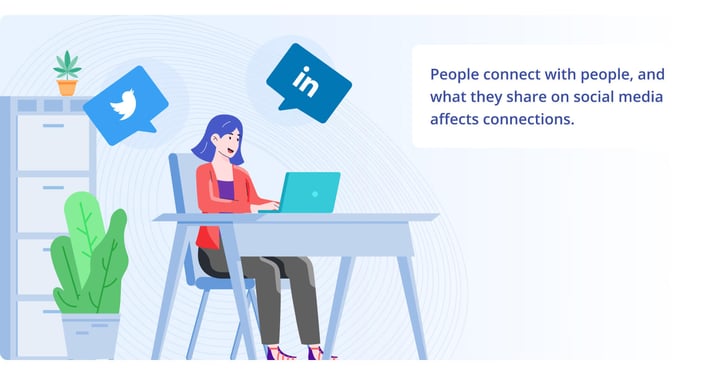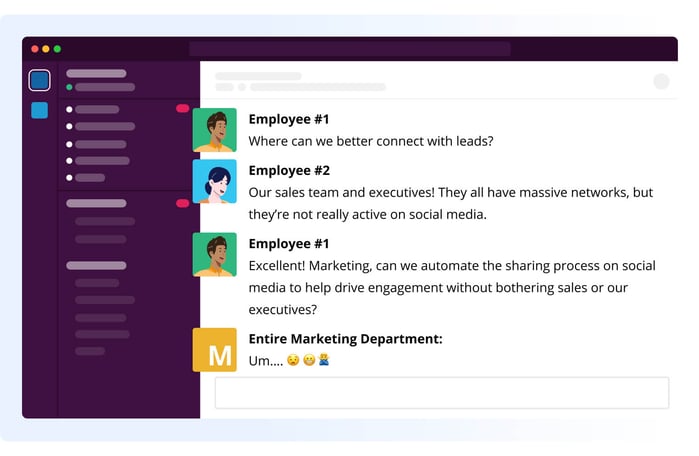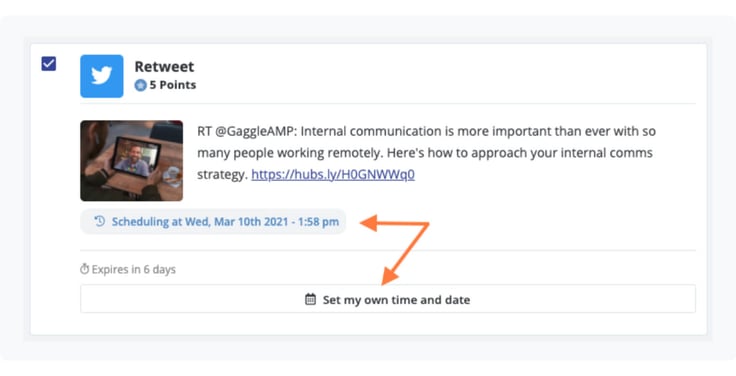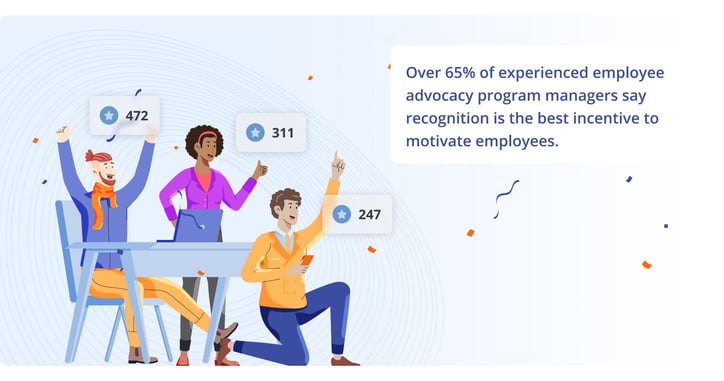Why Automatic Social Media Sharing Falls Short
It’s not uncommon for teams exploring an employee advocacy program to ask, “Can’t we just share this automatically on the employees’ networks?”
We get it. It sure would be easier. Your employees are busy, and you don’t want to interrupt their days.
But take a step back, and put yourself in their shoes. Would you like it if content is being shared to your networks without your approval?
Likely not.
Choosing an employee advocacy platform based on the ability to share posts automatically is a dangerous practice. That’s a turn-off to your employees and could really be a detriment to your partnerships.
What is Automatic Sharing?
Automatic sharing is the practice of sharing social media content directly to an employee's network. An employee can choose to ‘opt-in’ to a practice like automatic sharing, which eliminates the need for employees to read and approve the content before having it shared on their social networks.
This is very different from using a feature like AutoAMP, which allows you to pre-schedule certain network activities once you have viewed, and approved, that content to be shared.
In short, AutoAMP allows you to schedule an activity you have seen and approved to be sent to your network; Automatic sharing removes employee involvement and allows content to be shared directly to your personal network.
4 Reasons Automatic Sharing Should Not Be Used on Social Media
1. It May Go Against Community Standards
Social media networks exist to provide a space and community for conversations and content sharing with people in like networks. Joining these networks means that you have agreed to Terms of Service and adherence to Community Standards. Curious about what they say? Here are a few highlights:
|
|
Facebook recognizes that the use of the internet plus its platform can increase the likelihood for abuse. As such, one of their values is authenticity, which states: |
|
|
LinkedIn Professional Community Policies LinkedIn also focuses on being authentic in its statement “Be Trustworthy.” Specifically, they “require you to use your true identity on Linkedin, provide accurate information about yourself and your organization, and only share information that is real and authentic. |
That last part is important - automatic sharing is real, but it’s not authentic.
Bottom line: Social networks look for authentic engagements. It makes the community better for everyone.
2. Automatic Sharing Doesn't Give Authentic Engagements
There’s a reason why social media networks tout authenticity in their community standards - it makes for a better experience for everyone involved. Authentic social media engagement is the practice of reaching out and attempting to make a sincere and genuine connection with someone on social media through likes, retweets, shares, and most importantly, through comments and conversations.
And you might be thinking some automation is great, why is this such a big deal? Think of it like this: A marketer, business development rep, a CFO, and an engineer are all asked to write a tweet about something unique about their business.
No, this isn’t some kitschy dad joke. If you think about it, none of these pieces of content will be the same, and the topic may be different, too. We all have perspectives that are unique to us and resonate with audiences like us. Automatic sharing doesn’t pick up on that, meaning it’s likely to miss the mark with your employees' audiences.
So you can have a lot of tweets being pushed out on your behalf, but if there is no engagement, does it even really matter?
3. Automatic Sharing Impacts Your Employees’ Personal Brands
People connect with people, and what they share on social media affects connections.
Social media is a part of a personal brand. It can help define who you and your employees are in a professional setting and the value brought to the table.
But it’s also a lot like networking at an event - just learning their name isn’t enough. You need to learn something about them. And, people want to get to know you, too.

Authentically engaged people are powerful assets. When your employees have a well-defined personal brand, it can lead to speaking engagements, elevated thought leadership for your company, and even other job opportunities down the road (no need to worry employers, that’s a good thing!)
But to get to that point, they need to bypass the easy and invest the effort to generate this engagement. No amount of automatic sharing will pull that off.
4. It’s Not The Employee’s Voice
It’s pretty common to see this scenario play out:

It sounds harmless enough, but it can do a world of damage. The only person that can sound like you, and be genuine like you, is, well, you.
With a genuine employee advocacy program, you can pick and choose which activities best represent you and would resonate best with your audience. Many of those activities allow you to add your voice, unique perspective, or thoughts. Automatic social media sharing complicates this. Everyone has a different perspective and tone of voice used for their audiences, so bypassing the middleman can be pretty dangerous.
Automatic sharing Is Bad. What’s My Alternative?
Give your employees the benefit of the doubt. Many do want to participate in an employee advocacy program but they need to know how to participate in an employee advocacy program. Doing it for them won’t help them learn, so empower them.
“Companies with engaged employees outperform those without by over 200%.”
Train Your Employees on How Easy It Is To Execute an Activity
Start small with efforts like “liking” a company post or retweeting a tweet. Once they have the hang of it, start to introduce different types of activities like sharing a social media post with your own perspective prepended, or commenting on a post on social media. Genuinely participating in an employee advocacy program can take as little as 5 minutes per week when employees know how to participate.
Pro-Tip: You can schedule your activities with AutoAMP. This allows you to execute all activities once per week but to delay the posting of the activity until later in the week. This still keeps employees as active participants in employee advocacy but allows activities to trickle out all week long.

Show Your Employees the ROI
Seeing the benefits of participating in an employee advocacy program is usually seen in the growth of new connections, followers, and even more robust engagements and conversations. Employees notice this, especially if they have not been very active on social media. And for sales, they particularly benefit from employee advocacy as there is increased awareness of the employer brand, which often leads to more leads.
 “Members participating in an employee advocacy program with GaggleAMP see an average growth in followers in their network of 110%.”
“Members participating in an employee advocacy program with GaggleAMP see an average growth in followers in their network of 110%.”
Activate Your Executive Team
Executives love programs that provide results. If you have an executive team that is hesitant, start with a pilot program of strong performers. Use their results to approach the executive team. Executives want an environment that keeps their teams collaborating while driving ROI and employee advocacy can do just that.
And if you have executive buy-in from the start, let that help you grow and develop your program. Using a top-down approach to employee advocacy often helps with employee activation. Take advantage of it.
Use Gamification and Rewards To Make It Fun
Over 65% of experienced employee advocacy program managers say recognition is the best incentive to motivate employees.

GaggleAMP’s employee advocacy platform allows you to create a contest amongst your employees using gamification and leaderboards. At the end of each month or quarter, use the leaderboard to acknowledge the most active employees in your employee advocacy program. Plus, you can further incentivize employees to redeem the points awarded for completing activities by providing rewards and company swag that they can ‘purchase’ with the points they earned by participating in your employee advocacy program.
Are you ready to take your employee advocacy efforts to the next level? We’d love to hear from you - set up a demo today!











